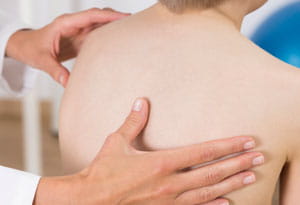Scoliosis Treatment
At the Crawford Spine Center, scoliosis treatment depends on your child’s age and the degree of their curve. Our goal is to stop your child’s scoliosis from getting worse and to correct the spine as much as safely possible.
If scoliosis is not treated, other potential health issues can develop, such as breathing trouble and heart problems. That is why getting your child the best treatment possible is so important.
Our spine team treats all types of scoliosis, including severe scoliosis. We offer a full range of treatment options, from conservative, non-invasive approaches to surgical reconstructive techniques.
Non-Operative Treatments
- Monitoring - For less severe curves that don’t need a brace, your doctor may monitor your child’s spinal curve. This includes having regular X-rays to watch for changes over time.
- Bracing - Bracing can correct spine problems by applying counter-pressure to the curve. This counter-pressure from the outside may allow for more normal growth. Bracing can be an option for kids over age 4 with a spinal curvature over 25 degrees.
If your child’s treatment includes wearing a scoliosis brace, they will receive a rigid, plastic brace that fits around the trunk and hips. Braces are worn for a certain number of hours a day, and can be removed.
- Casting - Casts are full-time braces that cannot be removed. Your doctor will work with you to determine whether a brace or cast could work best for your child. Our spine team uses a special casting technique that can help delay surgery until the teen years or avoid it altogether. Learn more about Mehta casts.
- Schroth Physical Therapy - Schroth Physical Therapy is a form of scoliosis-specific exercise. It is sometimes an option for people who are on the border for needing surgery. This therapy includes a variety of postural positions and exercises that are designed to address your child’s individual spinal curve.
Scoliosis Surgery
If your child needs surgery for scoliosis, your care team will discuss the options for their condition. We evaluate each patient individually. The recommendation for surgery is based on a number of factors. Types of scoliosis surgery we perform include:
- Spinal fusion - Fusion surgery permanently connects two or more vertebrae (bones in the spine) to correct a spinal curve. The surgeon fuses, or joins, the vertebrae together using a bone graft and hardware customized for your child.
When the surgeon approaches the spine through a person’s back, it is called a posterior spinal fusion. The Crawford Spine Center performs more than 100 posterior spinal fusions each year. When approached through the front, it is an anterior spinal fusion, which are far less common.
Spinal fusion stops the movement and growth of the vertebrae. This puts an end to increasing curves and spine deformities. You may also hear this procedure called spinal fusion with instrumentation. Instrumentation refers to the hardware such as rods and screws that can be used during a spinal fusion.
- Spinal fusion revisions - After an initial surgery, it is possible for some patients to have a deformity that continues to progress, symptoms that continue or get worse after surgery, or to develop new or different symptoms. In these cases, another surgery called a revision surgery could be recommended.
- Guided growth surgery / Growth guided devices - The goal of guided growth surgery is to correct the spinal curve while allowing the spine to continue to grow. In this surgery, rods are placed into anchors on each side of the spine. As the child grows, the rods slide within the anchors so the spine grows straighter along the rods.
- Traditional growing rods - Growing rods are a treatment for early onset scoliosis where metal rods are placed along the spine to correct the curve. Due to a child’s growth, the rods are replaced with longer rods about every six months during surgery.
- MAGEC rods - MAGEC rods are a treatment for early onset scoliosis similar to traditional growing rods. Once in place after an initial surgery, these rods can be lengthened outside of the body, without surgery, using a remote control and powerful magnets.
- Vertebral body tethering (VBT) - VBT is a treatment for adolescent idiopathic scoliosis where a strong cord called a tether is attached to the spine to correct the curve.
- Vertical expanding prosthetic titanium ribs procedure (VEPTR surgery) - In a VEPTR surgery, a curved metal rod is attached to the ribs to straighten the spine and separate the ribs. This creates more space in the chest so the lungs can expand and grow as the child grows. VEPTR is used to treat thoracic insufficiency syndrome (TIS).




